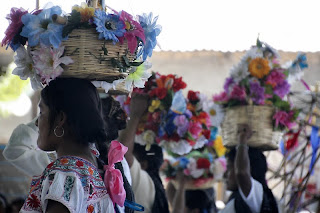Today was a day that all true travelers long for, the kind of day that is increasingly difficult to even hope for: a truly authentic and unself-conscious cultural encounter. I was invited, along with my chef friend Susana Trilling (www.SeasonsOfMyHeart.com), to a special historic holy place, a tiny, one-room adobe church atop an unmarked hill, to celebrate a mass honoring San Jose/St.Joseph,and to take part in the special social events to follow.
Villagers from 24 small pueblos came to the sacred hilltop to begin the day with a special outdoor mass. As there were about 350 people assembled, too large a group for the tiny chapel, we met under a huge green tarp, spilling out the sides into the warm sun. A new young priest extolled the virtues of St. Joseph, using parables to discuss good parenting to the local fathers; how good San Jose/St. Joseph must have been in order to raise Jesus from infant to adult. And do ye likewise. Mass took about two hours with much singing, loud boisterous calling out of prayers in unison, with lots of waving of arms…..a new experience for me in the Catholic mass.
And then, lunch!! Most of the villages had cooked for several days, and consequently there were at least 20 different large food areas under the partially leaved oak trees which the priest blessed individually, sprinkling food and folks with huge amounts of holy water.
Everyone was given enough food for a week. Yellow and red moles, enchiladas de frijol con yerba santa (sarsparilla),huge rolled soft tacos… Nopal/cactus salads with a light vinaigrette, both white AND blue corn posole, white beans with "amarillo,"(a spicy yellow sauce)”, black beans with "rojo,"(a red chile sauce). Egg tacos, and on and on…..…. All this was grown on their own small family plots. Plenty, more than plenty, for all, with a
lot left over. And all raised and prepared at home.
Why is there hunger in the world? The large, thin tortillas utilize homemade nixtamal (dried raw corn cooked in quicklime/calcium oxide, then ground to make the dough), and are made on a large wooden press.There are three varieties: all corn, all wheat, and 'revueltos,' a mixture of both grains. An early frost killed much of their corn crop last fall and wheat is added to stretch the corn…. home grown organic wheat added to home-grown organic corn!
When all were satiated, the party started. Guelaguetza dances, several bands, recitations, candy gifts for the kids. Women of all ages wore simple regional costumes for each dance, tossing the traditional 'gueza,' gifts of candy and fruits, to the excited and happy audience. A loud, very loud, brass band played and was mercifully on-key and in tune! A youth Christan Christian rock band made their first public appearance among these, their friends and family, and a new local teenaged heart throb was born. A young woman gave a short one-act play extolling safe teen-age driving in parables,to much applause.
We finally departed around four o’clock when a new band surfaced bearing huge speakers and a shrieking out-of-tune violin that created a sensation similar to ramming a dull nail into one's eardrums. Time to go!
These small villages, for consisting on of 60-75 houses are all located about 45 minutes outside of Nochixtlan, an hour north of the city of Oaxaca in la Mixeca region. They own few cars or TVs, and there is little reason to leave home, as they are all “campesinos” /(farmers) and life is filled with the daily chores of raising food, caring for small children and animals and the elderly --– up to four generations are in a family compound. The kitchens are usually NOT of concrete block , but ventilated thatched- roofed rooms with wood burning handcrafted stoves. The walls are thin tree or bamboo branches which have been roped or wired together. Dishes are hand-washed, clothes hung on the line to dry next to the huge adobe oven that bakes the weekly bread. A group of townspeople in each village are politically involved in keeping their planting seeds free of GMO's. They trade and and barter their millennium- old native drought resistant seeds within the community. They participate in special fairs educating about native seeds. Posters on the wall proclaim their reality --– to live by the teachings of their grandparents -- going back to the old ways, dependent only upon themselves for food and shelter. Sound good?
Back in the big city, Oaxaca City, and walking back late from too much food at dinner, I saw a wealthy family's stylized,very self-conscious wedding leaving a church, complete with fancy bridesmaids in Juchitan/Frida finery, and a very tuneful pricey brass band. A lovely procession with flower-filed baskets on heads led a raised ornate St Joseph saint. The rose-bedecked Rolls Royce convertible (rented, made from a fiberglass kit ) awaited the bride and groom. Quite impressive. But I walked away, rather over whelmed by the sumptuousness and staged feeling of it all after my wonderful, genuine day.
And then, down the block I suddenly spotted my favorite,very old and very sick,once-upon-a-time-beautiful but now ancient and scrawny and frail beggar, a woman I always seek out. I gave her too much. I keep expecting never to see her again and yet she persists.
Teary,tough contrasts. Quite a day.





















































